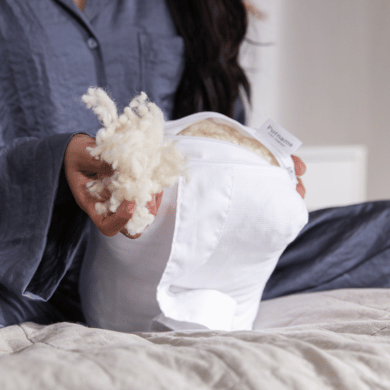
How to Create a Naturally Hypoallergenic Bedroom
Allergies can disrupt much more than your breathing, they interfere with sleep, productivity, and overall well-being. For those with asthma, eczema, or sensitive immune systems, the bedroom is often one of the most problematic areas when it comes to allergen exposure.
It’s no surprise, then, that more people are seeking practical ways to create allergy-friendly sleep spaces.
"The UK has some of the highest prevalence rates of allergic conditions in the world, with over 20% of the population affected by one or more allergic disorders". (M. L. Levy, 2004)
This guide will walk you through everything you need to know about building a naturally hypoallergenic bedroom. From identifying common triggers to selecting the best natural bedding materials and maintenance tips, we’ve got you covered.
See also - How Buckwheat Pillows Stay Sanitary and Eco-Friendly
Why Bedrooms Are a Common Source of Allergens
Your cosy, comfortable bedroom may unknowingly harbour irritants like dust mites, synthetic fibres, and even mould. Here’s what might be hiding in plain sight:
- Dust Mites
These microscopic bugs thrive in bedding, mattresses, and carpets, feeding on dead skin cells. Their presence can lead to sneezing, wheezing, and even asthma flare-ups.
- Synthetic Fibres
Common in cheap pillows, duvets, and mattresses, synthetic materials often exacerbate allergy symptoms, trapping allergens and releasing harmful chemicals.
- Poor Ventilation
Without proper airflow, rooms can become a breeding ground for mould, mildew, and dust particles.
Recognising these triggers is the first step in creating a cleaner, healthier sleep environment.
See also - Can Natural Pillows Help with Allergies?
Which Materials to Avoid and What to Choose Instead
Not all bedding materials are created equal.
Here’s what to skip and what to prioritise when building your allergy-friendly bedroom.
Materials to Avoid
- Synthetic Fabrics like polyester often trap dust and cause irritation.
- Feather Bedding, which can introduce dander and isn’t easily washable.
- Treated Fabrics, which may release VOCs (volatile organic compounds) that worsen respiratory problems.
See also - Air pollution and allergies at home (Asthma + Lung UK)
Best Natural Materials for Allergies
Switching to natural bedding is a game-changer for those with sensitivities.
Look out for the following materials:
- Organic Cotton
Breathable and chemical-free, cotton is a dependable choice for hypoallergenic sheets and pillowcases.
- British Wool
British wool is naturally resistant to dust mites and bacteria, wool duvets for allergy sufferers can regulate temperature while keeping allergens at bay.
- Buckwheat Hulls
Organic buckwheat hull pillows are dust mite resistant, making them excellent for people prone to allergic reactions.
- Graphite Latex
Graphite Latex is both dust mite resistant and wonderfully supportive, making it perfect for mattresses and pillows.
Switching to natural products isn’t just better for your health; it’s an environmentally conscious choice as well.
See also - Tips For Relieving Nighttime Allergies During Sleep
Benefits of British Wool, Organic Buckwheat and Graphite Latex for Allergy Sufferers
Natural materials go beyond just being allergen-friendly; they offer other benefits that make them ideal for a good night’s sleep.
British Wool
- Thermal Regulation
Keeps you warm when it’s cold and cool when it’s hot.
- Resists Dust Mites
Its natural lanolin coating makes it inhospitable for dust mites.
- Moisture-Wicking
Absorbs and dissipates moisture, preventing damp conditions where allergens thrive.
Organic Buckwheat Hulls
- Exceptional Support
Conforms to your neck and head, offering custom support while being completely breathable.
- Dust Mite Resistant
The hard buckwheat hulls don’t retain moisture or attract pests.
Graphite Latex
- Hypoallergenic Properties
Naturally antimicrobial, latex resists mould, mildew, and dust mites.
- Durable
High-quality latex products last for up to 15–20 years, making them a solid investment.
To experience these benefits first-hand, check out the Putnams collection, which offer natural pillows for allergies and other eco-conscious bedding options.
Cleaning Habits to Keep Your Sleep Space Allergen Free
Even with the best materials, maintenance is vital.
Allergy-friendly rooms require consistent cleaning and preventative care.
Weekly Cleaning Routine
- Wash Bedding
Wash sheets, pillowcases, and duvet covers weekly in hot water (at least 60°C) to kill dust mites.
- Vacuum Regularly
Use a vacuum with a HEPA filter to eliminate allergens from carpets, rugs, and even mattresses.
- Wipe Surfaces
Dust shelves, nightstands, and window sills with a damp cloth to prevent particles from becoming airborne.
Monthly Deep Clean
- Rotate Your Mattress
Flip or rotate your mattress to ensure even wear and prevent allergen build-up. If possible, encase it in a dust mite-proof cover.
- Clean Curtains
If you have fabric curtains, wash them monthly. Alternatively, switch to washable roller blinds for easier maintenance.
Ventilation Tips
- Open windows for 15 minutes daily to improve airflow.
- Consider investing in an air purifier to remove invisible allergens like pollen and dust.
See also - How Often Should You Change Your Pillow? The Complete Guide.

Best Hypoallergenic Bedding and Pillow Options
For an allergy-friendly bedroom, having the right products on hand is essential. Here are some top choices for bedding and pillows:
Recommended Bedding Options
- Wool Duvets for Allergy Sufferers
Naturally, repels dust mites and offers temperature regulation.
- Hypoallergenic Sheets
Organic cotton or eucalyptus fibre options feel luxurious while being gentle on sensitive skin.
Recommended Pillows
Ideal for those seeking dust mite resistance and neck support.
Dust mite proof, cooling, and adjustable for different sleeping preferences.
Perfect for daily use; combine with pillow protectors for extra defence.
Pro Tip: Pair your pillows and duvets with breathable mattress toppers made from organic wool or organic cotton for added layers of protection.
Final Checklist for an Allergy-Friendly Bedroom
To ensure your bedroom stays hypoallergenic, here’s a handy checklist to follow:
- [ ] Replace synthetic bedding with natural options like wool or organic cotton.
- [ ] Use dust mite-proof covers on your mattress and pillows.
- [ ] Wash all bedding weekly in hot water to eliminate allergens.
- [ ] Vacuum and dust your room frequently using a HEPA filter vacuum.
- [ ] Improve ventilation with regular airflow or an air purifier.
- [ ] Switch to easy-to-clean flooring or use washable rugs.
- [ ] Keep pets out of your bedroom to reduce dander.
Taking small, consistent steps can make a world of difference, helping you achieve restful sleep without compromising your health.

















Leave a comment